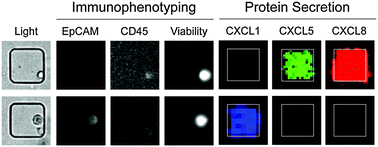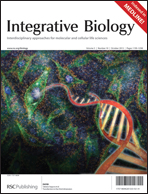Single cells from human primary colorectal tumors exhibit polyfunctional heterogeneity in secretions of ELR+ CXC chemokines†
Abstract
Cancer is an inflammatory disease of tissue that is largely influenced by the interactions between multiple cell types, secreted factors, and signal transduction pathways. While single-cell sequencing continues to refine our understanding of the clonotypic heterogeneity within tumors, the complex interplay between genetic variations and non-genetic factors ultimately affects therapeutic outcome. Much has been learned through bulk studies of secreted factors in the tumor microenvironment, but the secretory behavior of single cells has been largely uncharacterized. Here we directly profiled the secretions of ELR+ CXC chemokines from thousands of single colorectal tumor and stromal cells, using an array of subnanoliter wells and a technique called microengraving to characterize both the rates of secretion of several factors at once and the numbers of cells secreting each chemokine. The ELR+ CXC chemokines are highly redundant, pro-angiogenic cytokines that signal via the CXCR1 and CXCR2 receptors, influencing tumor growth and progression. We find that human primary colorectal tumor and stromal cells exhibit polyfunctional heterogeneity in the combinations and magnitudes of secretions for these chemokines. In cell lines, we observe similar variance: phenotypes observed in bulk can be largely absent among the majority of single cells, and discordances exist between secretory states measured and gene expression for these chemokines among single cells. Together, these measures suggest secretory states among tumor cells are complex and can evolve dynamically. Most importantly, this study reveals new insight into the intratumoral phenotypic heterogeneity of human primary tumors.


 Please wait while we load your content...
Please wait while we load your content...